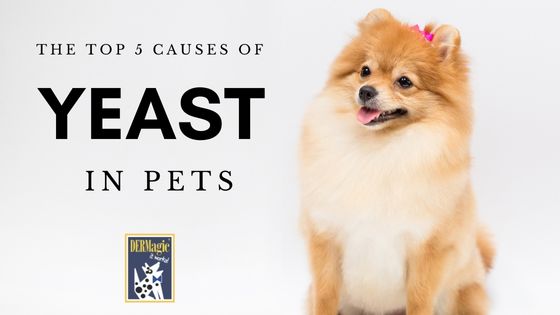
We field a lot of questions about skin here at DERMagic and one of the top questions is, “How did my dog get this condition?”
Alopecia X is a frustrating diagnosis to receive from your veterinarian. It essentially means, "loss of hair due to unknown cause". No one likes these types of vague diagnosis, especially not your vet.
Unfortunately, veterinarians don’t get a lot of training on skin conditions like Alopecia X, Black Skin Disease, hot spots or other issues.
Fortunately, we’ve been treating these conditions for a lot of years and can help out - naturally and effectively. The answer as to “why” is often complex and sometimes there is no answer at all. But, over the years, we have discovered that certain issues can contribute to yeast overgrowth.
1. Shaving and Injections
Our skin and our dog’s skin all maintain a delicate balance of microflora, which includes bacteria, mites, fungus and yes - yeast. One scrape, poke or cut can allow this cornucopia of fungi to enter our system, which can then wreak havoc on our body.
When animals are taken in for grooming, or shaved for a surgery or blood draw, there is a chance that these microscopic critters will make their way under the skin, multiply and devastate our pet’s skin health. It can even happen with a scrape from playing, or a vaccination - anything that punctures our pet’s most valuable protection: their skin and coat.
Learn more about this topic in our article, How Shaving can Cause A Lifetime of Problems.
2. Diet
Diet is an important consideration for helping your dog live a healthy life. It's especially important when you’re using DERMagic to treat Alopecia X, Black Skin Disease, or any other type of yeast-related issues.
Years of feeding the same type of food (usually chicken, beef, corn, and others) to our pets has created a sensitivity to these foods in many animals. This leads to poor gut health, which results in an overgrowth of yeast.
When treating yeast, we generally recommend exploring a raw or modified raw diet. However, it’s important to make the right decision for your pet with your veterinarian or canine/feline nutritionist. These diets also require a commitment from you to ensure your pet receives the proper nutrition. Learn more about your pet’s diet while treating for yeast here.
Probiotics and supplements can also play an important part in gut health. We discuss some possible options for supplements in this post.
There is no perfect pet food for dogs, just as there is no perfect food for humans. Ultimately, we have to make decisions based on nutritional science, our lifestyle, and our pet's individual preferences, body type, breed and sensitivities.
3. Reproductive Health
Veterinarians don't usually have a lot of experience with yeast and it’s rarely taught in colleges. In most cases, your veterinarian's first line of response to alopecia x will be: medication, castration, and ultimately, “learning to live with it”.
Most medications used to treat Alopecia X and Black Skin Disease can result in even worse cases of yeast. These medications include corticosteroids, antibiotics, and more. Together, they create a "perfect storm" that makes the condition even worse.
Topical medications often include chlorhexidine, miconazole, and ketoconazole. In difficult-to-treat or severe cases, oral antifungal medications are used. These include fluconazole, terbinafine, ketoconazole, and itraconazole. However, it's important to understand that these medications simply disguise the symptoms - they don’t resolve the problem.
Our all-natural approach is the best way to help your dog overcome yeast.
4. Thyroid and Endocrine Health
Endocrine glands (which includes the pituitary, thyroid, and adrenal glands) help control many body functions, including growth and development, metabolism, and fertility.
Sterilization is a common approach to resolving alopecia X, as the hormonal changes that take place after the procedure help calm the skin.
This is why it's recommended to have your pets spayed or neutered and to avoid breeding dogs with a history of fur loss.
Unfortunately, the results are not always permanent. If no other measures are taken to resolve the yeast, the coat re-growth does not stick around for long.
5. Breed and Genetics
You’ll see a lot of Pomeranians on our Facebook page and this is due to poms being some of the most common breeds with this condition. Why? Well, we don’t know for sure...
We do know that double-coated dogs who require a lot of grooming tend to be more prone to yeast overgrowth (which can include alopecia X, Black Skin Disease, Hot Spots and more).
Read more about some of the most susceptible breeds here.
What about Cyclical Yeast?
What happens when you go through a full treatment and the coat returns to normal, but then seems to disappear again every October or April?
Unfortunately, cyclical yeast can occur. While it is rare, it is very frustrating for owners and their dogs.
Cyclical yeast is often the result of environmental sensitivities. This may include a seasonal allergy, a recurring health condition, hormones, a new shampoo, or any other random thing.
These sensitivities combined with an overactive immune systems can be a recipe for cyclical yeast.
Certain types of medication can also inflame your dog’s system and result in yeast overgrowth. Be sure to discuss any medications with your veterinarian.


